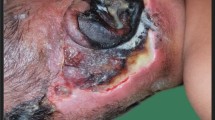Abstract
Objectives
To present the outcomes of our case series of head and neck necrotizing fasciitis (HNNF) in which vacuum-assisted closure (VAC) is used in most of the cases in the treatment.
Methods
Case series in a tertiary referral center.
Results
Eleven patients were treated for HNNF between January 2008 and January 2017. Patients were two females and nine males, the mean age was 57.1. Oral cavity and tracheotomy/tracheostomy sites were the main aetiological foci of the infection. Three patients were treated with aggressive debridements and conventional dressing, whereas eight patients were treated with incision and exploration followed by limited skin excisions and VAC dressing. The mean number of surgical debridements was 2.3. The mean length of hospital stay was 41.8 days. Complications were observed in all patients except one. The mortality rate of HNNF in our series was 18%. The cause of death was severe sepsis and multi-organ failure in one case and mediastinitis followed by respiratory distress syndrome in the other case.
Conclusion
HNNF is still a mortal disease and surgical debridements are crucial. The current study is the only case series in the literature in which VAC treatment was used in consecutive cases of HNNF. VAC treatment can play a major role in the post-operative care of HNNF patients. It reduces the amount of excised skin during debridements and stimulates wound healing. VAC treatment may be included in the treatment protocol of HNNF alongside surgical debridements and medical therapy.




Similar content being viewed by others
References
Wilson B (1952) Necrotizing fasciitis. Am Surg 18:416–431
Fernando DM, Kaluarachchi CI, Ratnatunga CN (2013) Necrotizing fasciitis and death following an insect bite. Am J Forensic Med Pathol 34:234–236
Wilkerson R, Pauli W, Coville FV (1987) Necrotizing fasciitis: review of the literature and case report. Clin Orthop Relat Res 216:187–192
Fink A, DeLuca G (2002) Necrotizing fasciitis: pathophysiology and treatment. Dermatol Nurs 14:324–327
Kessenich CR, Bahl A (2004) Necrotizing fasciitis: understanding the deadly results of the uncommon ‘flesh-eating bacteria’. Am J Nurs 104:51–55
Stone HH, Martin J Jr (1972) Synergistic necrotizing cellulitis. Ann Surg 175:702–711
Lin C, Yeh FL, Lin JT, Ma H, Hwang CH, Shen BH, Fang RH (2001) Necrotizing fasciitis of the head and neck: an analysis of 47 cases. Plast Reconstr Surg 107:1684–1693
Jallali N, Whitney S, Butler PE (2005) Hyperbaric oxygen as adjuvant therapy in the management of necrotizing fasciitis. Am J Surg 189:462–466
Novelli G, Catanzaro S, Canzi G, Sozzi D, Bozzetti A (2014) Vacuum assisted closure therapy in the management of cervico-facial necrotizing fasciitis: a case report and review of the literature. Minerva Stomatol 63:135–144
Wong CH, Khin LW, Heng KS, Tan KC, Low CO (2004) The LRINEC (Laboratory Risk Indicator for Necrotizing Fasciitis) score: a tool for distinguishing necrotizing fasciitis from other soft tissue infections. Crit Care Med 32:1535–1541
Endo S, Murayama F, Hasegawa T, Yamamoto S, Yamaguchi T, Sohara Y, Fuse K, Miyata M, Nishino H (1999) Guideline of surgical management based on diffusion of descending mediastinitis. Jpn J Thorac Cardiovasc Surg 47:14–19
Mao JC, Carron MA, Fountain KR, Stachler RJ, Yoo GH, Mathog RH, Coticchia JM (2009) Craniocervical necrotizing fasciitis with and without thoracic extension: management strategies and outcome. Am J Otolaryngol 30:17–23
Argenta L, Morykwas M (1997) Vacuum-assisted closure: a new method for wound control and treatment: clinical experience. Ann Plastic Surg 38:563–577
Oczenski W, Waldenberger F, Nehrer G, Kneifel W, Swoboda H, Schwarz S, Fitzgerald RD (2004) Vacuum-assisted closure for the treatment of cervical and mediastinal necrotizing fasciitis. J Cardiothorac Vasc Anesth 18:336–338
Sumi Y, Ogura H, Nakamori Y, Ukai I, Tasaki O, Kuwagata Y, Shimazu T, Tanaka H, Sugimoto H (2008) Nonoperative catheter management for cervical necrotizing fasciitis with and without descending necrotizing mediastinitis. Arch Otolaryngol Head Neck Surg 134:750–756
Krenk L, Nielsen HU, Christensen ME (2007) Necrotizing fasciitis in the head and neck region: an analysis of standard treatment effectiveness. Eur Arch Otorhinolaryngol 264:917–922
Lanisnik B, Cizmarevic B (2010) Necrotizing fasciitis of the head and neck: 34 cases of a single institution experience. Eur Arch Otorhinolaryngol 267:415–421
Fernando SM, Tran A, Cheng W, Rochwerg B, Kyeremanteng K, Seely AJE, Inaba K, Perry JJ (2018) Necrotizing soft tissue infection: diagnostic accuracy of physical examination, imaging, and LRINEC score: a systematic review and meta-analysis. Ann Surg. https://doi.org/10.1097/SLA.0000000000002774
Martinez M, Peponis T, Hage A et al (2018) The role of computed tomography in the diagnosis of necrotizing soft tissue infections. World J Surg 42:82–87
Kehrl T (2014) Point-of-care ultrasound diagnosis of necrotizing fasciitis missed by computed tomography and magnetic resonance imaging. J Emerg Med 47:172–175
Yen ZS, Wang HP, Ma HM, Chen SC, Chen WJ (2002) Ultrasonographic screening of clinically-suspected necrotizing fasciitis. Acad Emerg Med 9:1448–1451
Malghem J, Lecouvet FE, Omoumi P, Maldague BE, Vande Berg BC (2013) Necrotizing fasciitis: contribution and limitations of diagnostic imaging. Joint Bone Spine 80:146–154
Funding
The research received no specific grant from any funding agency in the public, commercial, or not-for-profit sectors.
Author information
Authors and Affiliations
Corresponding author
Ethics declarations
Conflict of interest
The authors declare that they have no conflict of interest.
Human and animal rights statement
This article does not contain any studies with human participants or animals performed by any of the authors.
Rights and permissions
About this article
Cite this article
Balcı, M.K., Ciğer, E., Arslanoğlu, S. et al. Necrotizing fasciitis of the head and neck: our experience with vacuum-assisted closure therapy. Eur Arch Otorhinolaryngol 275, 2555–2562 (2018). https://doi.org/10.1007/s00405-018-5096-z
Received:
Accepted:
Published:
Issue Date:
DOI: https://doi.org/10.1007/s00405-018-5096-z




